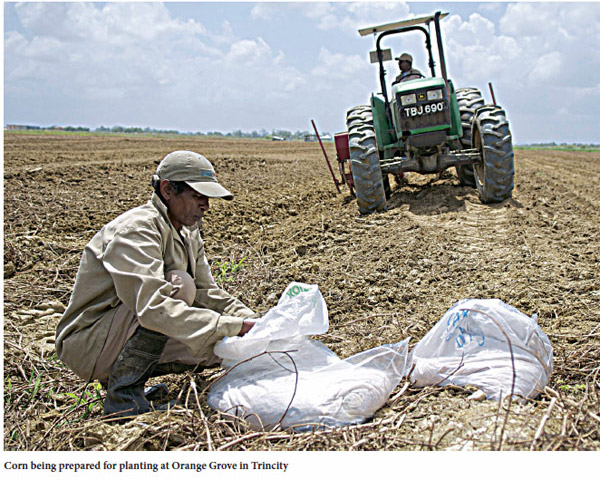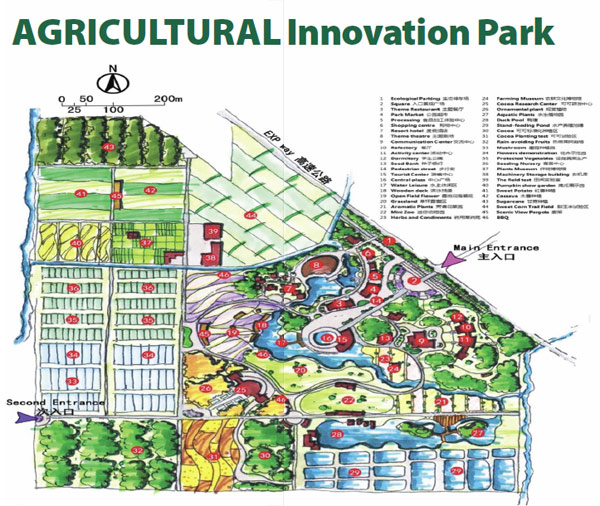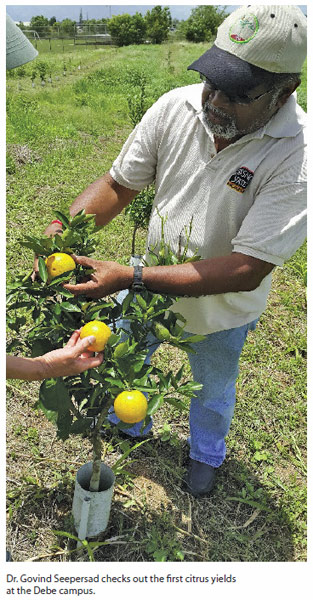 |
 |
 |
|
December 2018 |
But after the Agricultural College gave way to the St. Augustine Campus of The UWI, it began to lose its acreage. River Estate went to housing, and a significant proportion at Mt Hope was given over to the Eric Williams Medical Sciences Complex, which also houses the Faculty of Medical Sciences. The 100 acres that supported the University Field Station was trimmed to facilitate the Uriah Butler Highway. A lot of land had been lost, and the State offered to compensate. In the late eighties, 200 acres of land at Orange Grove in Trincity was promised, and nearly three decades later, tangible results are about to be seen. Within the next few years, Orange Grove will be the site of an Agricultural Innovation Park that will be known as The UWI’s east campus. The AIP, one of a kind in the region, will occupy all of the 200 acres provided by the State, and it will feature a wide range of agricultural concepts and activities that will stimulate both insiders and outsiders. How it came about is an interesting story. For some time, the Faculty of Food and Agriculture (FFA) had quietly been making its wish list but found it challenging to find resources to actualize it. Managing the 200 acres as farming land had been quite a stretch due to limited resources to support the development. However, as the Campus sought external partnership for the development of AIP, the Faculty has focused on transforming the Orange Grove field into a productive farm land primarily to support training of students and research while utilizing revenue generated to offset cost and acquire new technology. “Growing crops on 200 acres needs to be done with caution since it can affect the livelihood of small holder farmers. As the farm further develops through acquisition of value addition technologies, it will start making seeds of certain crops available to farmers for planting ensuring more symbiotic relationship in pursuit of advancement of food security objectives of the country and the CARICOM,” says Dr. Isaac Bekele, Dean of the FFA. Students have also been going there to do practical research and to get hands-on experience. It has been key as a teaching support and a site for experimentation and internship. Currently an experiment evaluating various irrigation technologies is being undertaken in collaboration with Dr. Dave Goorahoo, a visiting professor from the Center for Irrigation Technology (CIT), California State University, Fresno. Dr Govind Seepersad, Deputy Dean of the FFA, tells of the concept of ‘precision agriculture’ which will be evaluated by an interdisciplinary team. The precision comes from the use of remote sensing and drone technology, exciting innovations in the field that allows for optimal use of land and ideal observation in order to fine-0tune crop management. “These two pieces of technology [the irrigation systems and the drones] put us on par with the best universities in the world,” says Dr. Seepersad, adding that they are also working with the University of York in Canada. According to Dean Bekele, the initial planning exercise for the AIP was undertaken by a team of academics and engineers from partnering institutions of the Chinese Agricultural University (CAU) and the FFA in April 2014. The implementation of the plan has been underway in a staggered mode. For instance, a fruit orchard is being set up on about 10 acres at Orange Grove in addition to specially designed greenhouses of 2000m2 for testing and evaluation for the humid tropics. The Faculty has already established a citrus orchard in Debe on 8.5 acres; following a Brazilian model. “We may be the originators of the Julie mango in the world,” says Dr. Seepersad, recalling that Caroni Ltd had a mango orchard at La Gloria in Princes Town, but it no longer exists. Mango is moving away from being one of the non-traditional Caribbean food basket items, he says, for instance, “the Israelis and Australians have been doing a lot of mango research and are large in mangos.” These initiatives contain enormous potential for advancing the Trinidad and Tobago agri-food sector’s sustainable development agenda. However, the Faculty is well aware there needs to be investment in research and technology for the realization of the goal. With investment in research and technology and the partnership already in place, a strong foundation has been laid for sustainable advancement. It is for this singular goal that in December 2014, Professor K.E. Bingsheng, President of the China Agricultural University and Professor Clement Sankat, Principal of The UWI St. Augustine Campus signed the implementation agreement of the UWI-CAU Agricultural Innovation Park. “In order to further develop agricultural education, research, experimentation and demonstration in agriculture, the Parties will test new varieties, facilities, equipment, technologies, concepts and models at the Park. The Parties will also demonstrate cropping patterns and production flows of distinctive crops currently cultivated in Trinidad and Tobago,” says the agreement. The agreement also covers collaboration between the parties in training graduate students at the master and doctoral levels, and work on the possibility of the award of joint or double degrees to the successful candidates through a split-site engagement. Dean Bekele says they are evaluating and testing new crops from China: Chinese squash, peppers, bitter gourd, ten varieties of corn and pumpkin while they are waiting for the infrastructure to be set up. “As part of partnership in training, two students are currently at CAU pursuing the MSc degree in plant breeding. Then they will return to pursue the PhD programme in crop breeding and improvement in FFA through joint CAU/FFA supervision in the AIP facility. Currently, Cameedra Ram and Kezia Blackman are engaged in this programme and we are making arrangements to recruit three more candidates to join the scheme from August 2015.” He is proud that the AIP will be technology-driven at every stage of the production post-harvest chain. He says that although the AIP is referenced as tied to the East Campus, it encompasses the three UWI farms – Orange Grove, Debe and the Field Station at Mt Hope – totaling 305 acres of farm lands falling under the management of the FFA. However, the Dean expressed the need to further expand the farm land area to facilitate hands on training of our students as part of the University’s commitment and our effort to prepare work-ready graduates. “We have communicated this need to the relevant authority and we await a response,” he said. The food security agenda of the country and the region is tied to the presence of technology-proficient, entrepreneurial and dedicated agricultural graduates interested in pursuing the business of agriculture, operating in a venture capital environment suitable for agribusiness development. The development of the AIP will provide the technology resources needed for the training and the extra land will provide a useful input for students to develop critical farming skills utilizing technology while honing their entrepreneurial skills. “Let us make this happen, it is within grasp,” says the Dean.
This is the main component of the UWI-CAU Agricultural Innovation Park (AIP), a joint project of The UWI and China Agricultural University, which is currently being constructed at Orange Grove in Trincity. According to the design, The East Campus site is to be divided into seven areas, technology service (Region 1); aquatic production; leisure and recreation; commercial, mini zoo and the two largest allocations, crop (45 acres) and horticulture (60 acres). While some of the teaching and learning will take place on the 15 acres allocated to Region 1 which will house the main building, a video conference facility; a library; multi-function labs and classrooms, most of the space enables an outdoor, practical learning environment. The 45 acres for crops will support production and demonstrations for root vegetables, corn, pumpkin, etc, and a plant museum. Similar use will be made of the 60 acres for horticulture which is allocated for greenhouse production. The leisure and recreation areas (science popularization Zone) earmarked for 35 acres will be the spaces where most of you, the public visitors, will become most familiar with, as you walk through avenues and gardens lit with solar lamps or wind energy ones, or enter a photovoltaic building that is the tourist centre on your way to check out the mini zoo, or the duck pool or even the cocoa museum. In this contemporary mix of the rustic and the urbane, you will find that man and nature can cohabit in peace, if only humans would cherish and respect nature’s gifts.
|



 In faraway days, when the Imperial College of Tropical Agriculture was the place the world’s academics flocked to for training and research, ICTA was a sizeable landowner. The College had 860 acres, spread over Mt Hope, River Estate in Diego Martin and Santa Cruz by 1960.
In faraway days, when the Imperial College of Tropical Agriculture was the place the world’s academics flocked to for training and research, ICTA was a sizeable landowner. The College had 860 acres, spread over Mt Hope, River Estate in Diego Martin and Santa Cruz by 1960.  It is on 200 acres, just north of the Piarco International Airport and it is irrigated by three individual water systems: east, west and middle of the site. It doesn’t look like much more than grass and trees these days, but when it is finished, it will be a fascinating addition to the Caribbean landscape as the first agricultural innovation park in these parts.
It is on 200 acres, just north of the Piarco International Airport and it is irrigated by three individual water systems: east, west and middle of the site. It doesn’t look like much more than grass and trees these days, but when it is finished, it will be a fascinating addition to the Caribbean landscape as the first agricultural innovation park in these parts.  Re-Engineering a New Citrus Industry
Re-Engineering a New Citrus Industry